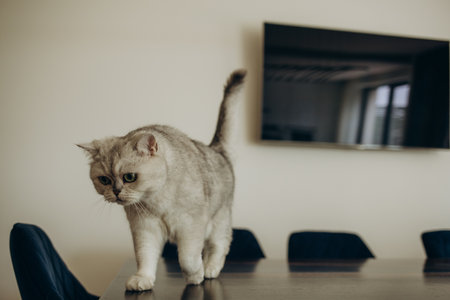Understanding the Basics of Cat Grooming
Grooming is much more than just keeping your cat looking neat and tidy—its a vital aspect of feline health and wellbeing. At its core, cat grooming includes practices such as brushing fur, trimming nails, cleaning ears, and sometimes bathing. While cats are known for their self-grooming abilities, they still benefit greatly from regular human assistance. Different breeds have unique grooming needs; for example, long-haired cats like Maine Coons or Persians require daily brushing to prevent painful mats and tangles, whereas short-haired breeds may only need a quick brush a few times a week. Additionally, some breeds may be prone to ear issues or skin sensitivities that necessitate special attention. Understanding these basics helps set the foundation for recognizing how grooming plays a crucial role in maintaining your cat’s overall health.
2. How Grooming Impacts Physical Health
Proper grooming does much more than keep your cat looking neat—it’s essential for their physical health. Regular brushing and combing help prevent common issues such as matting, hairballs, and skin infections. When a cat’s fur becomes matted, it can pull on the skin, causing discomfort or even pain, and can create hiding spots for parasites like fleas and ticks. By removing loose hair and preventing mats, you’re also reducing the risk of painful tangles that could lead to open sores or irritated skin.
Hairballs are another concern, especially for long-haired breeds. Cats naturally groom themselves by licking their fur, which causes them to swallow loose hairs. Without regular grooming from you, excess loose hair may accumulate in the digestive tract, leading to frequent hairballs or even dangerous blockages. Routine brushing significantly cuts down on the amount of hair your cat ingests, helping keep their digestive system running smoothly.
Grooming is also vital for maintaining healthy skin and coat. Brushing distributes natural oils throughout the fur, which nourishes the skin and gives your cat a shiny, soft coat. This process can also help you spot early signs of skin problems or infections before they become serious. Below is a quick overview of how grooming supports different aspects of your cat’s health:
| Health Issue | How Grooming Helps |
|---|---|
| Matting | Prevents tangles that cause pain and trap dirt or parasites |
| Hairballs | Reduces loose fur swallowed during self-grooming |
| Skin Infections | Allows early detection of wounds or irritations; promotes healthy oil distribution |
| Overall Coat Health | Keeps fur soft, shiny, and free from debris or excess shedding |
By making grooming a regular part of your cat’s routine, you’re not only improving their appearance but actively protecting them from common health challenges. Consistent care leads to happier, healthier cats—and fewer vet visits down the line!

3. The Role of Grooming in Early Detection
Regular grooming is more than just a way to keep your cat looking sleek and beautiful—it plays a critical role in your cat’s overall health by helping you spot early warning signs of potential health issues. When you take the time to brush your cat, run your hands through their fur, or inspect their skin, you’re also performing an informal health check that can reveal subtle changes before they become serious problems.
One of the most valuable aspects of grooming is its ability to help you detect unusual lumps, bumps, or swellings on your cat’s body. While cats are skilled at hiding discomfort and illness, these physical changes can be early indicators of infections, abscesses, or even tumors. Catching these issues early gives you and your veterinarian a better chance to address them promptly and effectively.
Grooming sessions are also an excellent opportunity to look for external parasites such as fleas and ticks. These pests not only cause itching and irritation but can also transmit diseases or lead to allergic reactions. Spotting parasites early allows you to take action before an infestation takes hold and affects your cat’s comfort and wellbeing.
Additionally, regular grooming helps you monitor for skin changes like redness, scabs, bald patches, or flakiness—signs that may point to allergies, fungal infections, or other underlying health concerns. By staying alert during grooming, you can track any developments and share this information with your vet at wellness visits.
In summary, routine grooming isn’t just about maintaining your cat’s appearance; it’s a hands-on way for pet parents to stay in tune with their feline friend’s health. Consistent attention to your cat’s coat and skin supports early detection and proactive care, fostering a happier and healthier life for your companion.
4. Grooming and Your Cat’s Emotional Wellbeing
Grooming is much more than just a way to keep your cat looking their best—it plays a vital role in supporting your cat’s emotional health. Regular grooming sessions can help reduce stress, build trust between you and your feline friend, and even encourage more positive behaviors around the home. Let’s take a closer look at the mental and emotional benefits of grooming for cats.
The Mental Benefits of Grooming
When you gently brush or comb your cat, it mimics the soothing sensation they experience when being groomed by their mother or other cats in a social group. This familiar feeling can help lower anxiety levels, making your cat feel safe and secure in your presence.
Emotional Advantages: A Quick Overview
| Benefit | Description |
|---|---|
| Reduces Stress | Calm, repetitive motions during grooming help relax your cat, especially during times of change or after stressful events like vet visits. |
| Builds Trust | Regular grooming sessions show your cat that you care, strengthening the bond and encouraging them to seek your company. |
| Encourages Positive Behavior | Cats who feel secure and cared for are less likely to display negative behaviors such as aggression or inappropriate scratching. |
Building Trust through Routine Care
Cats thrive on routine, and consistent grooming can become a cherished ritual that fosters trust. When you handle your cat gently and respectfully during grooming, it teaches them that human touch is safe—making future handling, whether for play or medical care, much easier for both of you.
Promoting Positive Behavior at Home
A well-groomed cat is often a happier, better-behaved companion. By helping your cat stay comfortable and relaxed, you’re setting the stage for fewer behavioral problems and a more harmonious household. In short, regular grooming nurtures not just your cat’s body but also their mind and spirit—helping them live their best life with you.
5. Professional Grooming vs. At-Home Care
When it comes to maintaining your cat’s health through grooming, you have two main options: visiting a professional groomer or handling the grooming at home. Both approaches offer unique benefits, and understanding the pros and cons of each can help you make the best choice for your feline friend.
Advantages of Professional Grooming
Professional groomers are trained to handle cats of all temperaments and coat types. They have specialized tools and knowledge to safely remove mats, reduce shedding, and check for signs of skin issues or parasites that might go unnoticed at home. For long-haired breeds or cats with thick coats, regular visits to a groomer can prevent tangles, discomfort, and even skin infections. Many groomers also offer additional services like nail trims, ear cleaning, and sanitary trims, which can be challenging for owners to do themselves.
Best Situations for Professional Grooming
- Your cat has a long or dense coat prone to matting.
- Your cat is elderly or has mobility issues making at-home care difficult.
- You’re uncomfortable handling certain grooming tasks like nail trimming.
- Your cat needs a thorough check for skin issues or parasites.
Benefits of At-Home Grooming
Grooming your cat at home is not only cost-effective but also strengthens the bond between you and your pet. Regular brushing helps reduce shedding around the house and allows you to spot changes in your cat’s skin or fur early on. With patience and positive reinforcement, most cats can learn to tolerate—and even enjoy—at-home grooming sessions. Plus, routine brushing can be a relaxing ritual that reassures your cat and keeps their coat shiny and healthy.
Tips for Effective At-Home Grooming
- Start slow and use treats to create a positive association with grooming tools.
- Use the right brush for your cat’s coat type: slicker brushes for long hair, bristle brushes for short hair.
- Check ears and nails regularly, but don’t hesitate to ask your vet or a professional for help if needed.
- Keep sessions short and stress-free; stop if your cat becomes anxious or agitated.
Finding the Right Balance
The best approach often combines both professional grooming and regular at-home care. While professionals can tackle more challenging tasks and provide deep cleaning, routine brushing and gentle maintenance at home will keep your cat comfortable between appointments. By staying proactive with grooming, you’ll support not just your cat’s appearance but their overall health as well.
6. Practical Grooming Tips for American Cat Owners
Grooming your cat doesn’t have to be a chore—it can actually become a special bonding time that benefits both you and your furry companion. Here are some practical, culturally relevant tips to help American cat owners incorporate grooming into their daily routines:
Make Grooming Part of Your Routine
Set aside just a few minutes each day or every other day for brushing your cat. Try pairing it with your own routine—perhaps after dinner or while watching your favorite TV show. Consistency helps your cat know what to expect and makes the process less stressful.
Create a Relaxing Environment
Choose a quiet spot in your home where your cat feels safe, like their favorite window perch or a cozy corner. Use gentle strokes and speak softly to create positive associations with grooming. Some cats enjoy light background music or calming scents like lavender (but always check that any product used is safe for pets).
Use the Right Tools
Invest in high-quality brushes and combs designed for your cat’s specific coat type, available at most American pet stores or online retailers like Chewy and Petco. Slicker brushes work well for most short-haired cats, while wide-toothed combs are better for long-haired breeds.
Turn Grooming into Bonding Time
Grooming is more than physical care—it’s an opportunity to connect emotionally. Give treats or extra pets as rewards during and after sessions. Over time, many cats come to look forward to this one-on-one attention.
Include the Whole Family
Encourage family members, including children, to participate in gentle grooming activities (always supervised). This not only teaches responsible pet ownership but also strengthens the bond between your cat and everyone in the household.
Keep It Stress-Free
If your cat shows signs of anxiety or resistance, try shorter sessions and gradually increase the duration as they get more comfortable. Never force grooming; patience and positive reinforcement will yield better results over time.
By making grooming an enjoyable part of your daily life, you’ll be supporting your cat’s health while deepening the special connection you share—a win-win for both you and your feline friend!

